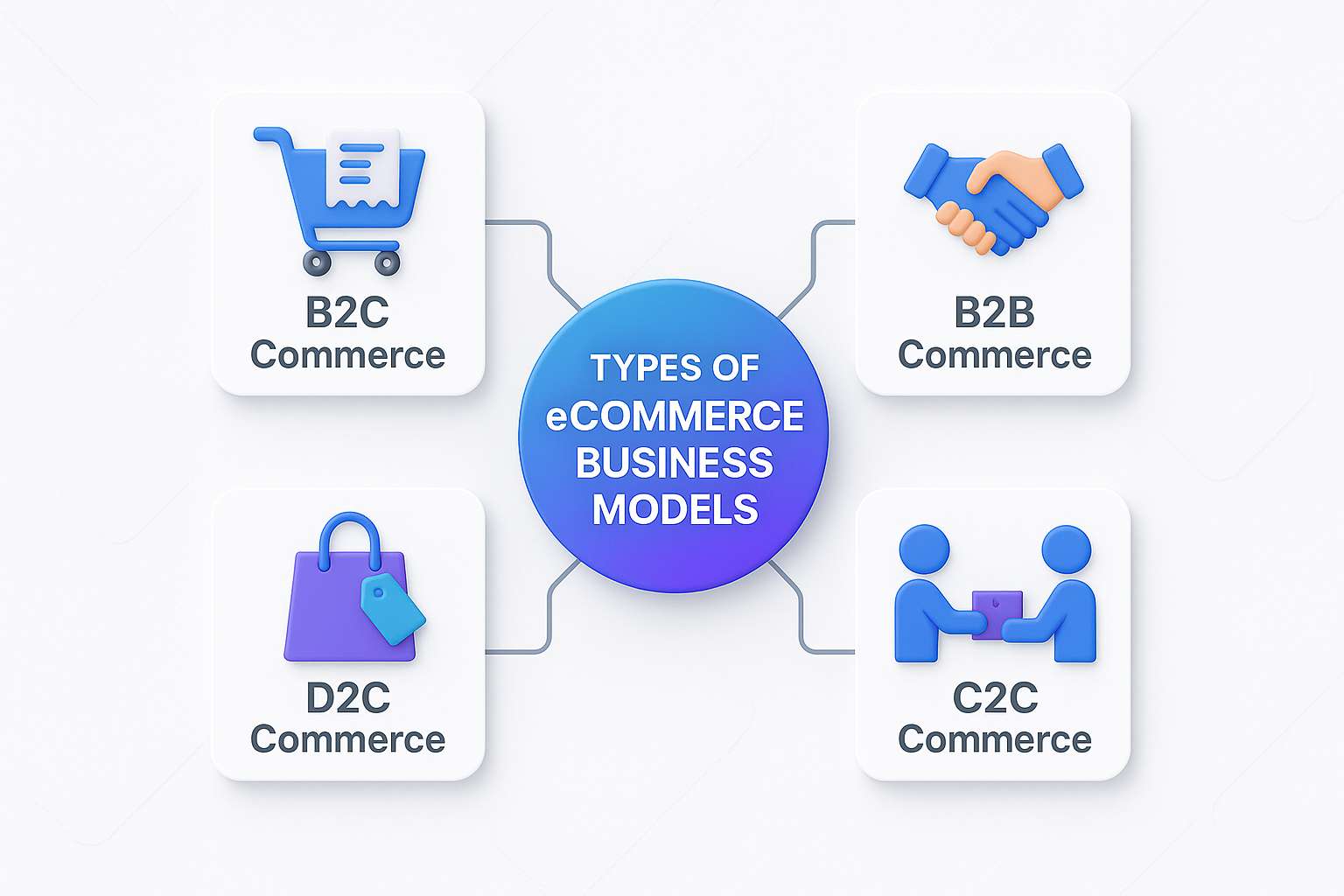Quick Links
ToggleWhen you’re thinking about starting an online business, it helps to know what type of eCommerce website will work best for you. Not every online store works the same way. Some sell directly to customers, some connect businesses with other businesses, and others create a platform for people to buy and sell with each other. Understanding these different types will help you choose the right path and build a website that fits your goals. Let’s take a look at the different types of eCommerce websites so you can get a better idea.
What is an eCommerce Website?
An eCommerce website is simply an online store where people buy or sell products and services through the internet. It works like a shop that’s always open, letting businesses reach customers anywhere and anytime. But not every eCommerce website works the same way. There are different types, and each one fits a different kind of business need.
Choosing the right type matters because it shapes how your customers feel when they visit your site, how smoothly your daily tasks run, and how easily you can grow when you need to. The right setup can make it easier to manage orders, handle payments, and create a good shopping experience that keeps people coming back. In the end, making the right choice can have a big impact on your sales and overall business success.
Types of eCommerce Websites by Business Model
Here are some common types of eCommerce websites based on business models:
-
B2C (Business-to-Consumer)
This is the most common type, where businesses sell directly to customers. Examples include Amazon, Nykaa, and ZARA. These websites usually have user-friendly storefronts, product catalogs, shopping carts, and easy payment options.
-
B2B (Business-to-Business)
Here, businesses sell to other businesses. Platforms like Alibaba and IndiaMART follow this model. These websites often offer features like bulk pricing, request-for-quote (RFQ) options, and login-based pricing systems.
-
C2C (Consumer-to-Consumer)
In this setup, individuals sell products or services to other individuals. OLX is a good example. These platforms act as marketplaces that connect sellers and buyers directly.
-
C2B (Consumer-to-Business)
This is less common but growing fast with the rise of the creator economy. Platforms like Shutterstock, Freepik, and influencer marketing websites allow individuals to offer content or services to businesses.
Types of eCommerce Websites by Structure and Functionality
When you look at how eCommerce websites work, you’ll see they’re built differently based on what they sell and how they run. Let’s break down some common types so you can understand how they function.
-
Single Brand Website (D2C eCommerce)
A single brand website is when a company sells its products directly to customers without any middlemen. This is called Direct to Consumer or D2C. Brands like Boat and Lenskart use this model to connect straight with their buyers. It’s perfect for startups and digital-first brands that want full control over their brand image and customer experience. If you’re building a D2C store, platforms like Zopping can help you set up the tech and tools you need to grow.
-
Online Retailer (Multi-brand Store)
This is an online shop that sells products from many different brands all in one place. Something like AJIO or BigBasket can be classified in this category. Running a multi-brand online store means dealing with a more complex system. You’ll need to manage various suppliers, track a larger inventory, and make sure your backend can keep up. These platforms need strong logistics and a reliable system to handle everything smoothly.
-
Marketplace Website
A marketplace brings in third-party sellers who list their products on your site. Amazon and Flipkart are classic examples. The platform earns money by taking a commission on each sale, running ads, or offering fulfillment services. This model works well because it gives customers lots of choices while the platform itself doesn’t need to hold all the inventory.
-
Subscription eCommerce Website
This type of site sells products or services that reach the customer on a regular basis, like every week or month. For example, SugarBox or Mamaearth’s subscriptions deliver items people need regularly. Running a subscription site means you need reliable payment systems, tools to manage customer churn, and ways to build loyalty so people keep renewing.
-
Service-Based eCommerce Website
Not all eCommerce sites sell physical products. Some sell services online like consulting, home cleaning, beauty treatments, or classes. Urban Company is a good example. These sites need features like scheduling, service listings, and customer ratings to help people book what they need easily.
-
Digital Products eCommerce Website
These websites focus on selling things that you download or access online such as courses, software, templates, or design assets. Platforms like Udemy or sites that sell Notion templates or Canva assets fall into this category. For these websites, it’s important to have secure file delivery, clear licensing, and smooth payment systems.
-
Dropshipping Website
Dropshipping is a model where the website sells products that are actually sourced from other suppliers. The site owner doesn’t keep inventory. Many Shopify stores use this approach. The main benefit is you don’t need a huge upfront investment but you do need reliable suppliers and careful management because profit margins can be thin and product quality must be consistent.
How to Choose the Right Type of Website for Your Business
Choosing the right website starts with knowing your business inside out. Here’s what you should think about:
-
Target Audience
Ask yourself who you’re building the website for. Is it young students, working professionals, parents, or business clients? Your design, language, and features should match the habits and preferences of your target group.
-
Product or Service Category
The kind of business you run matters a lot.
- Selling products? You’ll need an eCommerce setup with product listings, a cart, and payment options.
- Offering services? A site that highlights your skills, client reviews, and booking options will work better.
- Make sure the website reflects what you do.
-
Scalability and Logistics
Think long-term. Can your website grow with your business?
- Will it handle more visitors later on?
- Can you add features like shipping tools, customer support chat, or multiple payment gateways if needed?
- Choose a platform that won’t hold you back when things scale up.
-
Budget and Timeline
Set a clear budget and decide how soon you need the website live.
- A basic informational site costs less and takes less time.
- An advanced custom site needs more planning and budget.
- Stick to what makes sense for your stage of business.
Take your time with these points before jumping into website building. The right choice now saves time, money, and effort later.
Build the Right eCommerce Website with Zopping
Choosing the right eCommerce model is just the beginning. How you build and manage your online store is what really shapes your long-term success.
At Zopping, we help you make that happen. Our platform is designed to create scalable, no-code online store solutions that match your business needs. Whether you want to launch a D2C brand, set up a B2B portal, or run a multi-seller marketplace, we have the tools to get you there.
With Zopping, you do not have to stress about the technical side. We handle your product catalogs, subscription logic, logistics, and even secure digital file delivery if you sell digital products.
Here is what you get when you build your eCommerce website with Zopping:
- A ready-to-launch website tailored to your business model
- Tools to help you easily scale orders, manage catalogs, and serve more customers
- Smooth integrations with payment gateways, shipping services, and analytics platforms
- No-code customizations so you can make updates without needing a developer
- Full support for subscriptions, marketplaces, digital products, and much more
If you are still figuring out which eCommerce setup will suit you best, our experts are ready to help you decide.
Reach out to us today and let’s build an online store that grows right alongside your business.
Closing Thoughts
There’s no single formula for building an eCommerce website that works for everyone. Each type comes with its own pros, challenges, and ideal audience. What matters is choosing a setup that matches your business goals and can grow with you over time. With Zopping, you get a website that fits your needs, handles your daily tasks with ease, and grows with you as your business expands.



